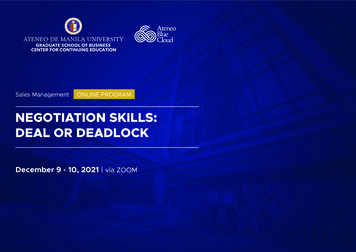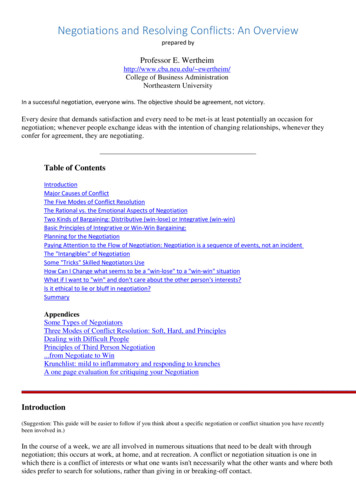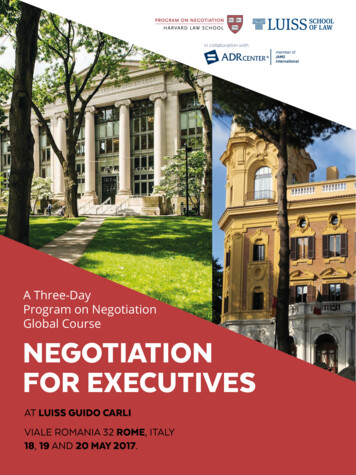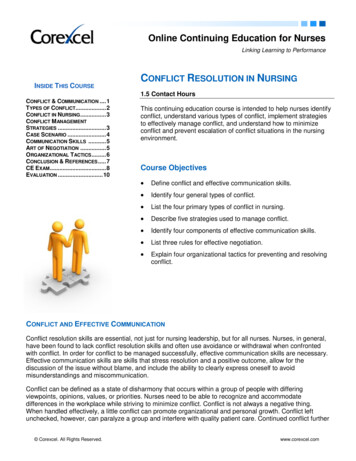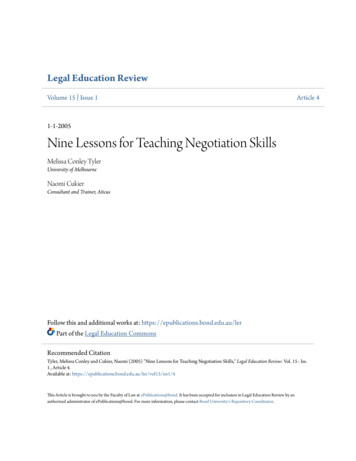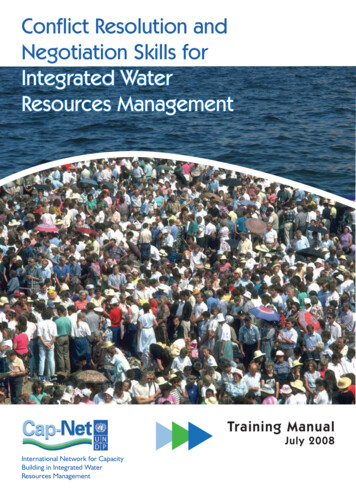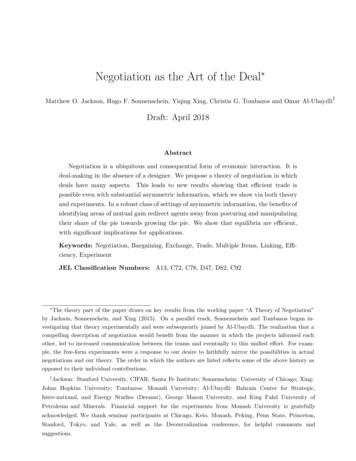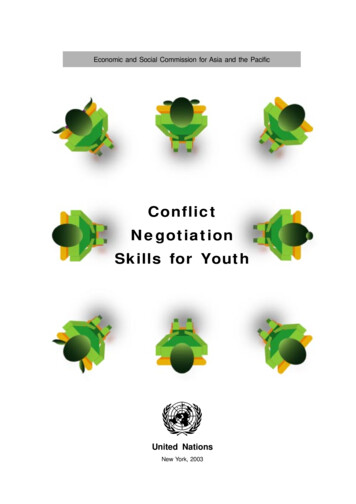
Transcription
Economic and Social Commission for Asia and the PacificConflictNegotiationSkills for YouthUnited NationsNew York, 2003169
ST/ESCAP/2286UNITED NATIONS PUBLICATIONSales No. E.03.II.F.50Copyright United Nations 2003All rights reservedManufactured in ThailandISBN: 92-1-120192-6The designations employed and the presentation of the material in thispublication do not imply the expression of any opinion whatsoever on thepart of the Secretariat of the United Nations concerning the legal status ofany country, territory, city or area, or of its authorities, or concerning thedelimitation of its frontiers or boundaries.This manuscript has been issued by the Health and DevelopmentSection, Emerging Social Issues Division, ESCAP. It has been issuedwithout formal editing. It may be reproduced or reprinted for non-profituse, with due acknowledgement to ESCAP.ii
PREFACEBackgroundThe ESCAP Module on Conflict Negotiation Skills for Youth was produced through thecollaborative efforts of ESCAP, the Christian Conference of Asia (CCA) and the ChurchDevelopment Service (EED), Germany. This Module is an output of the project entitled“Strengthening national human resource development capabilities in poverty alleviation and conflictnegotiation skills for youth.”The project aimed to promote conflict negotiation skills development for youth in participatingcountries through the training of government and non-governmental organization (NGO) personnelworking with youth.The Module was pilot tested in five countries in 2002: Cambodia, India, Myanmar, Philippinesand Sri Lanka. It was modified on the basis of pilot-test experiences. Anecdotes from thesehave been included in relevant sections.ObjectivesThe objectives of the Module are three-fold:1. To familiarize trainees with common concepts and themes on conflict negotiation skillsfor youth;2. To expose trainees to participatory training methods and increase their ability to usesimilar methods in their own training;3. To inspire and encourage trainees to refine and adapt training techniques andexercises in their own training events.Who is it for?The Module is intended for those who can adapt it for use in designing training programmes foryouth on conflict negotiation skills.Several of the skills in the Module have been specifically designed to provide time for trainees toreflect on how the material could be adapted to their own contexts.Structure and contentThe Module is divided into nine main Sessions, under three core Sections, aimed for delivery ina five-day course.Section I:Youth and the conflicts they face in daily lifeSession 1:Understanding youthSession 2:Understanding conflictiii
Section II:Techniques for resolving intrapersonal and interpersonal conflictsSession 3:Self-awarenessSession 4:CommunicationSession 5:NegotiationSession 6:MediationSection III: Techniques for resolving group conflictSession 7:Group buildingSession 8:Team building and cooperationSession 9:Advocacy for youth developmentContent focusThe Module focuses on interpersonal conflict and the skills that young people can use to identifyand resolve them. It is based on the premise that conflict in itself is neither “good” nor “bad”,but that the outcome depends on how the conflict is handled. Depending on how a conflict ishandled, the result can be either positive or negative. The Module highlights diverse attitude andbehaviour patterns during interaction and in conflict. Furthermore, it introduces techniques tohandle conflict in a non-violent manner, such as, mapping needs and fears, negotiation andmediation.The focus on interpersonal skills should in no way minimize other development and social justiceprocesses that are central to resolving wider social, economic and political conflicts. Thepremise of the Module is that youth can serve as agents of change to promote a culture ofpeace, provided their voice is heard. Training youth in conflict negotiation skills is an importantbasis for strengthening their own life skills and a step towards a wider peace-building process.Use and adaptationBearing in mind the wide variety of ways in which conflict is defined and resolved in diversecultural contexts, and the sensitivity attached to it, further adaptation may be necessary in theapplication of this Module. Terms such as “conflict” and “conflict negotiation” may, for example,need adaptation, in collaboration with course organizers and trainees, to ensure a commonunderstanding of the terms, prior to training.Users should adapt the Module to make it relevant to their specific local contexts. The Moduleis organized in a loose-leaf format to make it more user-friendly. This gives users the flexibilityto add locally-relevant information to any section of the Module.We encourage the wide use of this Module, its adaptation, and its translation, with attributiongiven to ESCAP.We would also appreciate receiving your feedback on this Module.to the ESCAP secretariat at the following address:Please send your commentsChiefHealth and Development SectionEmerging Social Issues DivisionUNESCAP, United Nations BuildingRajdamnern Nok Avenue, Bangkok 10200, ThailandFax: (662) 288 3031E-mail: escap-healthdev@un.orgiv
MODULE FRAMEWORKMeaning & Importance Understanding youthUnderstanding conflictIntra & InterpersonalConflict NegotiationTechniquesConflictnegotiation skillsfor youthdevelopmentCourseIntegration up ConflictNegotiation Techniques Group buildingTeam building & cooperationAdvocacyv
ACKNOWLEDGEMENTSThis Module was developed by UNESCAP in collaboration with the Christian Conference of Asia (CCA). Ms A sa Jonsson, in her then role as Health and Development Section(HDS) coordinator for the project entitled "Strengthening national HRD capabilities inpoverty alleviation and conflict negotiation skills for youth", prepared the overallframework for this Module. Ms Jonsson also managed the pilot testing and interpretationof feedback and comments for finalization of the Module.The preliminary draft of the Module was prepared by Professor Prabha Chawla.Subsequent contributing authors of the Module were Ms Sudha Nair (Sessions 3 and 4)and Ms Editha Maslang (Sessions 7 and 8). Mr Richard Kaing, Training Expert, HDS,documented the pilot testing of the Module.The HDS consultants who contributed noteworthy inputs to the Module were Ms Soe LeAung and Ms Hayman Win. Ms Patricia Persad and Ms Janet Maychin, HDS, revisedthe manuscript and Ms San Yuenwah, HDS, undertook its final editing for publication.Our special gratitude goes to the national counterpart organizations and participants ofthe five national-level courses that pilot tested the Module (Cambodia, India, Myanmar,Philippines and Sri Lanka), for their useful feedback and suggestions.vi
CONTENTSPAGEPreface .iiiAcknowledgement .viFacilitator’s guide .viiiSECTION I:YOUTH AND THE CONFLICTS THEY FACEIN DAILY LIFESession 1: Understanding youth .1Session 2: Understanding conflict .17SECTION II: TECHNIQUES FOR RESOLVING INTRAPERSONALAND INTERPERSONAL CONFLICTSSession 3: Self-awareness .34Session 4: Communication .54Session 5: Negotiation .69Session 6: Mediation .93SECTION III: TECHNIQUES FOR RESOLVING GROUP CONFLICTSession 7: Group building .107Session 8: Team building and cooperation .123Session 9: Advocacy for youth development .145References .165vii
FACILITATOR’S GUIDEFacilitator profileThe facilitator(s) who will conduct the training should be: Able to handle group dynamics, potential tension and conflict between group members,excessively dominant or passive participants and the expression of strong emotion. Familiar with the culture of the participants and sensitive to cultural differences (eitherbetween group members, or between facilitator(s) and participants). Aware of gender, age and ability differences and how these affect conflict mediationwithin specific cultural contexts.If possible, consider having two facilitators to co-facilitate, particularly for a long training or alarge group.Two facilitators can model cooperative ways of working together, demonstratedifferent facilitation styles and provide more attention during small group work.If interpretation is required, it is important to select interpreters who are able to sufficientlyfamiliarize themselves with the content and can be flexible during session delivery.Further guidelines for the facilitator are listed in Appendix A (p. xiii).Planning trainingFor a checklist of items to consider before conducting training, see Appendix C (p. xviii).Before carrying out training, it is important to assess the needs of the participants by asking thefollowing questions:viii Who has requested this training? Have the participants been personally affected by conflict/violence in their community?If so, how? Who are the participants?of the facilitator? What is their age group? Does it differ from that of the facilitator?Why is training felt to be necessary?What are the important social and political conditions in the community in which thetraining will take place? What is the recent history, if any, of conflict and/or violencein the community?What is their cultural background?Does it differ from thatWhat is the educational background of the participants?What experience do the participants have with training on conflict resolution?What do participants see as major issues in conflict resolution for young people?What types of conflict resolution methods have been used, or are being used, in thecommunity? Who is involved?
Pre-training considerationsWhat traditional ways of resolving conflict might still be used?What do the participants think of these approaches?Ethical considerations (Hollier 1993)As training in conflict negotiation skills may involve expressing emotions and opinions, thefacilitator is responsible for being aware of certain ethical issues in the group. These include: Making clear to participants the objectives of the training. Making clear to participants that they have the freedom not to participate in an activityif they feel uncomfortable. Ensuring privacy – participants should not feel pressured to reveal personal informationif they do not want to. Ensuring confidentiality on personal matters discussed during the course. Being aware of any emotional distress in a participant and making provisions for thatperson to be appropriately supported. Seeking feedback and evaluation from participants and taking it into serious consideration in planning the sessions that follow.Maintaining equal participation and minimizing tendencies of certain individuals todominate or monopolize discussion.Providing adequate time for the debriefing of each activity, so that any strong feelingsthat may have been raised can be aired.Practical considerationsThe facilitator will need to make sure that the space for training is large enough for both fullgroup and small group work. Having cosy “break-out” areas for small-group work can be helpful.Furniture should be easy to move to allow for flexible groupings.Conducting large groupsessions with the group seated in a circle is better for discussion dynamics than row-styleseating.Agenda settingThe agenda should be finalized in advance of the training, specifying clearly the rules andresponsibilities of each facilitator (if there is more than one). The agenda can be confirmed withthe participants in the setting of ground rules (see below), including the time to be allocated forlunch and tea/coffee breaks. If any adjustments need to be made, this can be decided duringthe first session of the training.Introducing the trainingix
Introducing the trainingIcebreakersIcebreakers are useful at the start of training to: Help participants to get to know each other. Create a stimulating learning environment.Some examples of icebreakers are provided in Appendix B (p. xiv).EnergizersEnergizers can be inserted at any point during training to “liven up” a session and enhanceparticipants’ learning. If the facilitator does not have any energizers planned, participants maybe asked to take charge of these activities that can include songs and short games.Some facilitators prefer to use energizers that are linked closely to the topic of the sessions.Some examples of this type of energizer are inserted in the sessions in this Module.Ground rulesAt the start of a training course, it is important to establish ground rules among the participantsand the facilitators. This can be done through an open forum, participants suggest the rules,which the facilitator notes down on flip chart paper. Once this exercise is completed, the sheetof paper can be placed in a visible place in the training venue.Hopes and expectationsAt the start of the training, participants may be uncertain about what they will be asked to do,and whether the training will prove useful for them.One way to address this is to askparticipants to note down the following on two coloured cards (using a different colour for each):(a) What do I hope to get out of the course? (Expectations)(b) What do I want to avoid during the training? (Fears)The cards can then be placed anonymously in a pile.When all the cards are in, theparticipants return to the pile and each draw one card. Each participant reads one card to therest of the group. A brief discussion can follow, in which people’s hopes and expectations areacknowledged.Facilitation techniquesThis Module is designed using a mixture of interactive facilitation techniques, including plenarysessions, small-group work (buzz-groups) and role plays. These are explained in detail below.(For further techniques, see Appendi C (p. xviii).In an interactive session, participants are able to: xSeek clarification.Raise questions.Think actively.Verbalize assumptions.Practise what they learn.
During such a session, the facilitator: Feels challenged.Develops relationships with the learners.Begins to understand the learners’ needs, limitations and strengths.Starts responding to the learners’ needs.Starts learning herself/himself.Adds to her/his own knowledge.Plenaries"Plenaries" is a method used for bringing all the participants back together after they haveworked in small groups or on individual and sub-group activities or assignments. Plenaries cantake the form of short reports presented to the rest of the group by nominated spokespersons orinformal but structured group discussions.Plenaries need to be controlled, as they can either become rushed and ineffective, or slow andtime-consuming. The facilitator should set strict time limits for each spokesperson and work outbeforehand the time allocated for each presentation in a plenary session.The facilitator should be able to manage feedback and be prepared to ask the contributor forfurther clarification on points.Small-group work (buzz-groups)Within a training session, a small group would usually have four or five members. Small groupswork on tasks identified in the whole group (plenary). Small groups may work in parallel or ondifferent parts of the same task.Small-group work can be used in many situations, for example, whenever participants need toexchange experiences, make decisions or tackle problem-solving tasks.Some management is necessary to ensure the effectiveness of small-group work.should ensure that:The facilitator Groups know and understand the task assigned to them. Decisions are taken on how to handle intergroup questions and comments.The facilitator is available for further clarification while the task is in progress.Feedback from small groups is properly managed and group rules established so thateach group knows how long their presentation will last.Role-playsRole-plays are a valuable tool in training. They have two main uses: Illustrate experiences of the participants that are relevant to the training, e.g., adispute between siblings in a workshop on conflict negotiation. Provide participants with the opportunity to rehearse situations they anticipate couldtake place, e.g., a quarrel between youth clubs to test out possible responses andoutcomes.Participants may volunteer for different roles or may be selected by the facilitator. The chosenparticipant should avoid playing her or his own role in a conflict that they have experienced inreal life. Acting should be as spontaneous and as real as possible. Role-plays normally lastonly a few minutes. Role-plays may be conducted by the whole group or by smaller groups.They may be presented in turn by the smaller groups to the whole group or done as a “fishbowl” exercise where only a few actually take part while the others observe.xi
Every role-play needs to be followed by a debriefing session for participants to discuss how theyfelt and to share new insights.Using audio-visual materialsWhiteboardsA whiteboard is used to list key points, to illustrate (such as a plan or diagram) or to recordideas and information from the group.Whiteboards are good for exercises such as brainstorming, where the facilitator needs to write alot of ideas quickly. However, when using the whiteboard, only write down key issues or ideas,and allow participants enough time to take down or think about the ideas for themselves.Flip chartsFlip charts are useful when points made or ideas shared are referred to in subsequent sessions.These can be displayed around the room. They can also be kept for future reference or for usein further training exercises.Overhead ProjectorThe overhead projector (OHP) is an effective and convenient way of displaying information andemphasizing points. It also has an important advantage over boards and flip charts, in that inusing it, the facilitator does not turn her/his back on the group.When preparing transparencies, avoid putting too much information on each sheet.be large enough to be read by everyone.Text has toEvaluationEvaluation is a crucial process in any training module. Evaluation can be done both during thetraining and at the end, in order to further improve the planning and facilitation of sessions of thatparticular training or for future training workshops. On-going participatory evaluation during trainingcan also help engage participants and provide them with ownership of the training process.Evaluation during the trainingOne technique is to provide daily evaluation sheets, which are collected at the end of each day(see Appendix E). These should be analyzed and synthesized in the evening, and reported atthe plenary the next morning to decide on possible changes if needed.Small groups can also be formed during the start of the training (when setting the ground rules),with each group allocated a day each (during the training) to report to the facilitating team afterthe sessions. This facilitates open dialogue between participants and the facilitators in a smallersetting and can provide a venue for useful comments.Evaluation at the end of the trainingEvaluation can be incorporated in the summary session of the training. One technique is to usethe “cabbage game”, whereby a series of questions to evaluate the course are written on sheetsof (green) paper. These sheets are then crumpled together to symbolize leaves of a cabbage.The facilitator starts the game by asking participants to sit in a circle. The facilitator then throwsthe cabbage to the participants. The participant who catches the cabbage gets to open the first“leaf”, reads the evaluation questions aloud and responds to it in plenary. The participant thenthrows the cabbage to another participant, and the process is repeated. This exercise can alsobe used during training to gauge the participants’ understanding of the sessions.At the end of a training session, a final evaluation form can be circulated for each participant tocomment more extensively on the training experience, and whether skills and knowledge haveimproved as a result of the training.xii
Appendix A:SOME DO’S AND DON’TS FOR FACILITATORSDO’SDON’TSHave only one main aim per session.Have more than one aim per session.Prepare the sessions thoroughly – it iseasier to prevent problems than to solvethem.Have too many ideas or too many activitiesper training course.If there is more than one facilitator, makesure that each facilitator knows exactly whichtask s/he is responsible for.Be flexible – have extra items you can add ifthere is more time than expected, and beprepared to exclude some items if there isless time than expected.Be prepared to adjust activities to accommodate more or fewer participants thanexpected.Use jargon (you want your participants tounderstand you rather than to be confusedby your vocabulary).Worry if an exercise fails – try to find outwhy by discussing it with the group.Substitute an activity even ifconsensus among participants.thereisRepeat points when it is not necessary.Plan enough breaks.Get to know the participants’ names (namelabels) and affirm each of them (e.g.,acknowledge each contribution made duringthe course).Adjust your language to suit the group.Use different methods of communication.Repeat points when necessary.Allow others to take responsibility, but knowwhen to be firm and when to assertauthority.Try to include everybody.xiii
Appendix B:ICEBREAKERS“Draw-your-profile”1.Distribute a sheet of A4 paper and a marker to each participant.2.Ask every participant to draw herself/himself and sign her/his name at the bottom of thepaper (10 minutes).Each drawing can represent a participant in his/her work situation, or something symbolizingwhat each participant likes about their working with youth.3.Ask participants to explain their drawings to the others.This activity should take 40 minutes.MaterialsA4 paper and marker for each participant and others present in the room.xiv
Facilitator’s notes1.The objectives of this activity are: To break the ice and create an atmosphere for learning and active participation amongparticipants. To enable participants to get to know one another.2.It is a good idea for everyone in the room to participate in this activity, including thefacilitators.3.The drawings can be displayed in the room afterwards for the duration of the training course.xv
“Human Bingo”Distribute a “bingo sheet” to each participant (sample below, which can be modified according tothe local context).Explain to the participants that they should try to identify a suitable participant for eachcategory. The aim is to get a row (vertical, horizontal or across) “filled”. The first person thatgets this should call out “Bingo!”Ask participants to share in plenary what they have identified for each category, and verify the"facts" as group.This exercise should take about 25 minutes.MaterialsA4 paper and marker for each participant and others present in the room.A4 paper “bingo sheets”HUMAN BINGO!Worked the most yearswith youth issues.Travelled the furthest tocome to (training location).Has the most number ofchildren.Has the nicest smile.Attended the most numberof training courses.Has conducted the mostnumber of training courses.Gets up the earliest inthe mornings.Worked the most years inacademia/university.Has the loudest voice.xvi
Facilitator’s notes1.2.The objectives of this activity are: To break the ice and create an atmosphere for learning and active participation amongparticipants. To enable participants to get to know one another.In some cultures the concept of “bingo” may be new, and a description will be required forthe game.xvii
Appendix C:A QUICK LOOK AT TRAINING TECHNIQUES AND METHODSMethodDescriptionBrainstormingA technique for generating many ideas uncritically without commentsand evaluation and only “considered” later.Buzz-groupsA short period during a session in which several small groupsintensively discuss a given issue, often followed by a plenary.Case studyAn in-depth analysis of real life or simulated problems for participants to identify principles or suggest solutions.ControlleddiscussionsA discussion in which students raise questions or comments, butthe facilitator controls the general direction of the discussion.FishbowlA discussion group in an inner circle surrounded by a silentobserver group, often followed by a plenary session or role reversal.Free group discussionA group discussion in which topics and direction are largely controlled by the participants and not the facilitator.Problem-centred groupA group is provided a specific open-ended task. Findings are reported at the plenary session or summarized on a flip chart orwhiteboard.ProjectsA practical group exercise or academic activity involving investigationof a problem.Pyramid(also called Snowball)An “idea” generating technique whereby groups of two briefly discussa problem, then form groups of four for further discussion prior toreporting to the whole group.QuestionsFacilitator displays questions, gives participants time to think andthen elicits answers for discussion and elaboration by the group.Could be used as a quiz for teams.Role-playA technique in which participants act out different roles in particularsituations and later discuss their feelings and aspects of theproblem.SeminarGroup discussion of a paper presented by a participant .Simulation and gamesAn exercise involving essential characteristics of a specific realsituation where participants re-enact specific roles.Step-by-step discussionsA discussion organized around a carefully prepared sequence ofissues and questions to draw out the required information from theparticipants.SyndicateSeveral sub-groups forming part of a larger group, each working ona problem for a period of time and reporting later to the wholegroup.TutorialA meeting with a small group.WorkshopA participatory experience involving several methods and directed atdeveloping skills or attitudes.xviii
Appendix D:CHECKLIST FOR FACILITATOR1.Get to know the participants as much as possible: who they are, how many there are,languages and cultural backgrounds.2.Make sure you and others organizing the workshop are in tune with what you are actuallygoing to do.3.Make sure the participants are aware of what they are going to take part in.4.Check the venue and facilities. If possible, visit the place where the workshop will be held,assess what needs to be added or adapted.5.Write a list of what is needed and give it to the person in charge of the facilities, including: flip chartsmarkerschalkmasking tape or drawing pinstape recorderoverhead projectordrinking waterother items to be identified for each course6.If you cannot visit the venue in advance, make sure you are there early, before the participantsarrive, so that you can organize what has not been done, or adapt the programme to fit thereality.7.Make sure the participants have all the information they need, especially if the workshopgoes on for several days, including: 8.A map so they can find their wayTime-schedule for buses or trainsPhone number where you can be reached if necessaryContact person and details, in case participants need to call in on an emergencyAsk the participants in advance if they have any special needs related to food, accommodation,and access to training venue and course information.xix
Appendix E:DAILY FEEDBACK SHEETDAY 1(This box is optional)Name:Title/Position:How are you feeling?[(Please check one)][][Q1.What did you find most interesting about today?Q2.What do you think could be improved for tomorrow?Q3.What other suggestions, comments or questions do you have?] Thank you for your feedback Please leave this sheet in the box located at the exitof the training room as you walk outxx
SESSION 1Understanding youthTOPIC 1Defining youthTOPIC 2Identifying priority youth issuesTOPIC 3Youth participationDuration of this Session: 4 hoursSession ObjectivesThe objectives of this Session are:QTo define the term “youth”, including the United Nations definition, and discuss howthis definition differs from that of “children”.QTo enhance understanding of the particular characteristics (including common stereotyping) of youth.QTo identify and discuss priority youth issues, and consider the role of youth workersin meeting the needs of youth.QTo discuss the concept and importance of youth participation.1
Conflict Negotiation Skills for YouthList of HandoutsPAGE1-1Questions and answers about youth .51-2Common stereotyping of youth .61-3The multiple “selves” of youth .71-4Problem tree analysis .111-5What is youth participation? .141-6Levels of youth participation .151-7Advantages of youth participation .16List of reading materialsSecretary-General’s 741/76/PDF/N0274176.pdf?OpenElementWorld Programme of Action for the Year 2000 and pay.pdf2
Section I: Youth and the Conflicts They Face in Daily LifeSession 1: Understanding youthTOPIC 1: Defining youthDu
negotiation skills for youth.” The project aimed to promote conflict negotiation skills development for youth in participating countries through the training of government and non-governmental organization (NGO) personnel working with youth. The Module was pilot tested in five countries i


